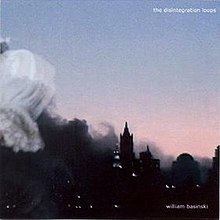Released 2002/2003 Label 2062 | Recorded 1982 Release date 2002 Songs dlp 1.1, dlp 2.1 | |
 | ||
Length 74:28 (I)75:00 (II)72:28 (III)74:26 (IV) Watermusic(2000) The Disintegration Loops(2002) Genres Ambient music, Drone music, Avant-garde music Similar The Disintegration Loops III, 92982, The Disintegration Loops II, Variations: A Movemen, Variations for Piano & Tape | ||
William basinski the disintegration loops
The Disintegration Loops is a series of four albums by American avant-garde composer William Basinski released in 2002 and 2003. All tracks have the same form of ambient music fragments played in a tape loop that slowly deteriorates as it passes by the tape head, increasingly producing noises and cracks in the music as the theme progresses. The recording coincided with the 9/11 attacks and the album covers and accompanying videos feature a still skyline of New York City with smoke and dust rising from the World Trade Center site.
Contents
The series gathered undivided favorable reviews. It was reissued in 2012 on the tenth anniversary as a 9-LP box set and received a rare perfect 10 rating from Pitchfork.
Content
The Disintegration Loops is based on Basinski's attempts to salvage earlier recordings made on magnetic tape, by transferring them into digital format; however, the tape had deteriorated to the point that, as it passed by the tape head, the ferrite detached from the plastic backing and fell off. The loops were allowed to play for extended periods as they deteriorated further, with increasing gaps and pauses in the music. These sounds were treated further with a spatializing reverb effect. Basinski has said that he finished the project the morning of the September 11 attacks on the World Trade Center in New York City, and sat on the roof of his apartment building in Brooklyn with friends listening to the project as the World Trade Center towers collapsed. In 2011, Basinski corrected earlier reports where he described recording the last hour of daylight of 9/11 in N.Y.C. with a video camera focused on the smoke where the towers were from a neighbor's roof, then set the first loop as the sound-track to that footage. Stills from the video were used as the covers for the set of four CDs.
Reception
The music review online magazine Pitchfork Media placed The Disintegration Loops I-IV at number thirty on their list of top fifty albums of 2004 and at number 196 on their list of top 200 albums of the 2000s. In 2016, the same magazine ranked The Disintegration Loops I-IV in third place in their list of the 50 Best Ambient Albums of All Time. It was also named the 86th best album of the decade by Resident Advisor, and the 10th best of the 2000s by Tiny Mix Tapes.
On the afternoon of September eleventh, 2011, Basinski's work was performed at the Metropolitan Museum of Art in New York City as a live orchestration to mark the tenth anniversary of the terrorist attacks.
2012 reissue
On September 4, 2012, New-York based record label Temporary Residence reissued the entire Disintegration Loops series as a massive 9xLP box set, marking the project's 10-year anniversary as well as its impending induction into the National September 11 Memorial & Museum.
Named The Disintegration Loops, the remastered collection was released in a limited edition of 2,000, complete with a 5xCD version, 63-minute DVD, and 144-page coffee table book with photos and liner notes by Basinski, Antony, David Tibet, Ronen Givony and Michael Shulan.
In addition to the four volumes of the series, the reissue includes two previously unreleased orchestral performances; one recorded live during a Wordless Music event at the Metropolitan Museum of Art on September 11, 2011, and one recorded at the 54th Venice Biennale. These two tracks are included on the fifth disc of the CD version as The Disintegration Loops V.
